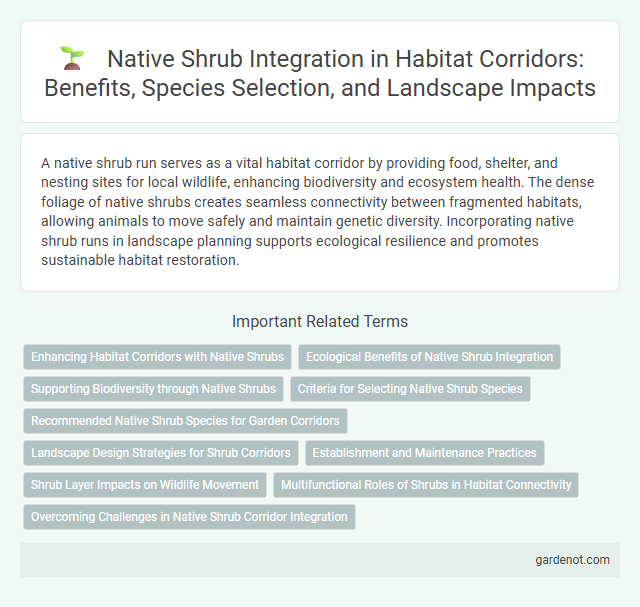A native shrub run serves as a vital habitat corridor by providing food, shelter, and nesting sites for local wildlife, enhancing biodiversity and ecosystem health. The dense foliage of native shrubs creates seamless connectivity between fragmented habitats, allowing animals to move safely and maintain genetic diversity. Incorporating native shrub runs in landscape planning supports ecological resilience and promotes sustainable habitat restoration.
Enhancing Habitat Corridors with Native Shrubs
Native shrub runs play a crucial role in enhancing habitat corridors by providing continuous, dense cover that supports wildlife movement and biodiversity. These native shrubs improve habitat connectivity, offer food resources, and create shelter for various species, thereby strengthening ecological networks. Integrating diverse native shrub species into habitat corridors promotes resilient ecosystems and facilitates species adaptation to environmental changes.
Ecological Benefits of Native Shrub Integration
Native shrub integration within habitat corridors enhances biodiversity by providing essential food and shelter for pollinators, birds, and small mammals. These shrubs improve soil health through nitrogen fixation and organic matter contribution, fostering a resilient ecosystem. Their root systems stabilize soil, reduce erosion, and support water filtration, promoting overall habitat connectivity and ecosystem function.
Supporting Biodiversity through Native Shrubs
Native shrub runs create essential habitat corridors by providing shelter, food, and nesting sites for diverse wildlife species, thereby supporting local biodiversity. These corridors facilitate species movement and genetic exchange, which is vital for maintaining healthy ecosystems and resilience against environmental changes. Incorporating native shrubs like chokeberry, red osier dogwood, and serviceberry enhances ecosystem services by attracting pollinators and supporting native bird populations.
Criteria for Selecting Native Shrub Species
Selecting native shrub species for a habitat corridor requires evaluating ecological compatibility, such as soil type, moisture levels, and local climate conditions to ensure successful establishment and growth. Species that provide food and shelter for indigenous wildlife, including birds and pollinators, are prioritized to enhance biodiversity and ecosystem connectivity. Emphasis on growth rate, root structure, and disease resistance optimizes habitat stability and corridor functionality over time.
Recommended Native Shrub Species for Garden Corridors
Recommended native shrub species for garden corridors include Ceanothus, Arctostaphylos, and Sambucus, which provide essential habitat and food sources for local wildlife. These shrubs support pollinators like bees and butterflies, while also offering shelter and connectivity for birds and small mammals. Selecting drought-tolerant and region-specific native shrubs enhances corridor effectiveness by promoting ecological resilience and biodiversity.
Landscape Design Strategies for Shrub Corridors
Native shrub runs enhance habitat corridors by providing continuous cover and food resources for wildlife, facilitating safe movement across fragmented landscapes. Incorporating diverse native shrub species with varying heights and bloom times supports pollinators and bird populations, increasing ecological resilience. Strategic placement along natural pathways and water sources maximizes connectivity and promotes biodiversity within urban and rural landscape designs.
Establishment and Maintenance Practices
Establishing native shrub runs within habitat corridors requires selecting region-specific species that enhance biodiversity and provide essential cover for wildlife. Regular maintenance practices include periodic pruning, invasive species control, and soil monitoring to ensure healthy growth and ecological balance. Proper management supports corridor connectivity, promoting wildlife movement and resilience in fragmented landscapes.
Shrub Layer Impacts on Wildlife Movement
Native shrub runs create dense understory layers that enhance habitat corridors by providing critical cover and foraging opportunities for wildlife, facilitating safer movement across fragmented landscapes. The structure and composition of the shrub layer influence species-specific movement patterns, with dense vegetation supporting smaller mammals and ground-nesting birds by reducing predation risk. Maintaining diverse and continuous shrub layers within habitat corridors ensures ecological connectivity, promoting gene flow and population resilience.
Multifunctional Roles of Shrubs in Habitat Connectivity
Native shrub runs serve as essential habitat corridors by providing shelter, food, and breeding sites for diverse wildlife species, thus enhancing biodiversity within fragmented landscapes. These multifunctional shrubs facilitate animal movement and gene flow between isolated habitats, supporting ecosystem resilience and long-term species survival. Their dense foliage and root systems also contribute to soil stabilization and microclimate regulation, further promoting habitat connectivity.
Overcoming Challenges in Native Shrub Corridor Integration
Native shrub corridors face challenges such as habitat fragmentation and invasive species encroachment, which can disrupt ecosystem connectivity and biodiversity. Effective integration relies on strategic planting of native shrub species like Ceanothus and Manzanita to enhance wildlife passage and soil stabilization. Utilizing adaptive management and community collaboration supports restoration efforts and mitigates barriers to corridor functionality.
Native shrub run Infographic

 gardenot.com
gardenot.com